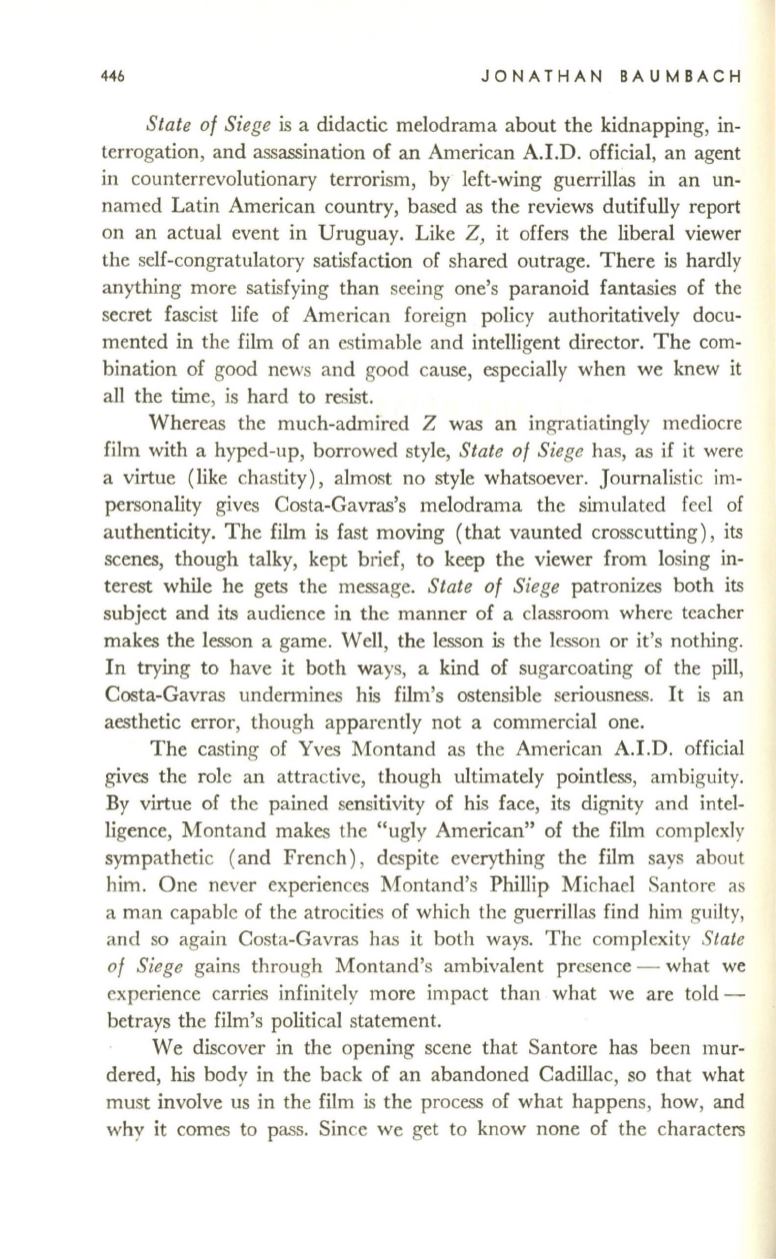
446
JONATHAN BAUMBACH
State of Siege
is a didactic melodrama about the kidnapping, in–
terrogation, and assassination of an American A.LD. official, an agent
in counterrevolutionary terrorism, by left-wing guerrillas in an un–
named Latin American country, based as the reviews dutifully report
on an actual event in Uruguay. Like Z, it offers the liberal viewer
the self-congratulatory satisfaction of shared outrage. There is hardly
anything more satisfying than seeing one's paranoid fantasies of the
secret fascist life of American foreign policy authoritatively docu–
mented in the film of an estimable and intelligent director. The com–
bination of good news and good cause, especially when we knew it
all the time, is hard to resist.
Whereas the much-admired Z was an ingratiatingly mediocre
film with a hyped-up, borrowed style,
State of Siege
has, as if it were
a virtue (like chastity), almost no style whatsoever. Journalistic im–
personality gives Costa-Gavras's melodrama the simulated feel of
authenticity. The film is fast moving (that vaunted crosscutting), its
scenes, though talky, kept brief, to keep the viewer from losing in–
terest while he gets the message.
State of Siege
patronizes both its
subject and its audience in the manner of a classroom where teacher
makes the lesson a game. Well, the lesson is the lesson or it's nothing.
In trying to have it both ways, a kind of sugarcoating of the pill,
Costa-Gavras undermines his film's ostensible seriousness. It is an
aesthetic error, though apparently not a commercial one.
The casting of Yves Montand as the American A.LD. official
gives the role an attractive, though ultimately pointless, ambiguity.
By virtue of the pained sensitivity of his face, its dignity and intel–
ligence, Montand makes the "ugly American" of the film complexly
sympathetic (and French) , despite everything the film says about
him. One never experiences Montand's Phillip Michael Santore as
a man capable of the atrocities of which the guerrillas find him guilty,
and so again Costa-Gavras has it both ways. The complexity
State
of Siege
gains through Montand's ambivalent presence - what we
experience carries infinitely more impact than what we are told–
betrays the film's political statement.
We discover in the opening scene that Santore has been mur–
dered,
his
body in the back of an abandoned Cadillac, so that what
must involve us in the film is the process of what happens, how, and
why it comes to pass. Since we get to know none of the characters


